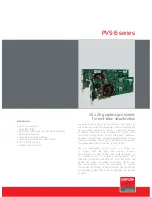
Programming 64
3.6 Example of a PCI PIO Sliding Window Operation for RFM-5565
RFM
‐
5565
cards
are
currently
available
with
128
or
256
MByte
of
installed
memory.
Under
some
circumstances,
it
is
useful
to
reduce
the
PCI
memory
address
space
window
size.
For
example,
a
BIOS
may
have
difficulty
dividing
the
address
space
into
enough
windows
with
appropriate
granularity
for
all
of
the
installed
devices.
In
another
example,
the
operating
system
may
not
be
able
to
assign
resources
for
all
of
the
drivers
loaded.
Reducing
the
PCI
window
size
allows
the
RFM
‐
5565
to
use
a
smaller
footprint
on
the
PCI
bus
address
space.
However,
changing
the
PCI
PIO
window
size
does
not
affect
other
functions
of
the
card.
All
of
the
installed
memory
on
the
card
can
be
updated
by
data
packets
on
the
Reflective
Memory
network.
For
example,
a
256
MByte
card
will
reflect
every
value
written
in
the
256
MByte
Reflective
Memory
network
address
space.
Also,
the
RFM
‐
5565
DMA
engine
can
be
used
to
access
every
byte
of
the
memory
installed
on
the
card.
It
is
also
possible
to
move
(remap)
the
PCI
PIO
window
to
access
every
byte
of
the
memory
installed
on
the
card
using
PIO
accesses.
Here
is
a
brief
description
of
selecting
the
PCI
memory
window
size.
There
are
four
possible
choices:
2
MByte,
16
MByte,
64
MByte
or
use
the
default
full
memory
size.
Two
switches
on
S1
are
used
to
configure
the
PCI
memory
window
size.
The
switch
settings
should
only
be
changed
while
the
power
is
off.
Use
S1
switch
positions
3
and
4
to
select
one
of
the
four
window
sizes.
Bits
20
and
21
of
RFM
register
LCSR1
(PCIBAR2
Offset
$08)
indicate
the
full
installed
memory
size.
Bit
19
of
LCSR1
is
connected
to
S1
switch
position
3
and
bit
22
of
LCSR1
is
connected
to
S1
switch
position
4.
Both
bits
19
and
22
can
be
read
by
software
(‘1’
when
on,
‘0’
when
off).
The
table
below
lists
the
number
of
PCI
PIO
window
selections
available
with
various
RFM
‐
5565
memory
options.
Two
registers
in
PCIBAR0
are
used
to
implement
the
PCI
PIO
Sliding
Windows.
The
LAS1BA
register
(Direct
Slave
Local
Address
Space
1
Range,
PCIBAR0
Offset
$F0)
is
read
‐
only.
It
is
determined
by
switch
settings
and
the
installed
memory
option.
The
LAS1RR
(Remap)
register
(Direct
Slave
Local
Address
Space
1
Local
Base
Address,
PCIBAR0
Offset
$F4)
is
writeable
in
bits
27:21.
The
32
‐
bit
register
masks
off
invalid
upper
and
lower
bits
based
on
switch
and
installed
memory
settings
(defaults
to
$00000001).
Consider
this
example
with
a
PCI
PIO
window
set
to
2
MByte.
First,
the
firmware
will
set
the
range
register
to
$FFE00000
to
indicate
a
2
MByte
PCI
PIO
window.
Next,
the
system
(BIOS)
will
set
the
PCI
Base
Address
(PCIBAR3)
on
a
2
MByte
boundary.
For
example,
the
BIOS
could
set
the
PCIBAR3
to
$F7600000
(allowing
a
PCI
window
up
to
$F77FFFFF).
This
serves
as
the
PCI
Base
Address
for
PIO
access
to
the
local
Reflective
Memory
address
space.
The
firmware
also
defaults
setting
the
Remap
Value
to
0
at
the
beginning
of
the
installed
memory
address
PCI PIO
Window
Size
Switch S1
Position 4
Switch S1
Position 3
LCSR1
bit-22
LCSR1
bit-19
Number of
PIO Windows
with 64 MByte
Number of
PCI Windows
with 128 MByte
Number of
PIO Windows
with 256 MByte
Default
Off
Off
0
0
1
1
1
64 MByte
Off
On
0
1
1
2
4
16 MByte
On
Off
1
0
4
8
16
2 MByte
On
On
1
1
32
64
128







































